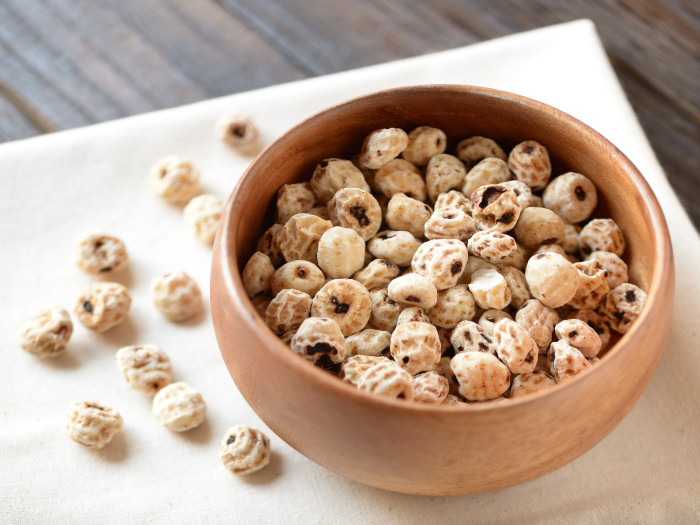Tiger nuts are an important culinary and nutritive crop in various parts of the world and have been throughout history, but there are many surprising benefits of this popular tuber. Let’s find out more!
What are Tiger Nuts?
Tiger nuts, also commonly known as chufa, are the edible tubers of the Cyperus esculentus (nutsedge) plant, which has been cultivated for at least 9,000 years for its nutrient density and oils. These nuts aren’t actually nuts, although they are commonly referred to as earth almonds. They taste a bit sweet and nutty just like pecans and almonds. While these plants are considered weeds in certain places, the dense nutrient profile of these tubers makes them an important source of resistant starch fibers. [1]
Tiger nuts can be eaten raw; however, they are more flavorful when they are soaked and softened. Try adding them to your salad or soup; you can also grate them. Tiger nut flour and granola are gluten-free options and you can buy them in select health food stores as well as online. You can also make your own trail mix by mixing the tubers with nuts, toasted rolled oats, chocolate, and dried fruit.
Horchata de chufa (tiger nut milk) is a popular sweet Spanish drink made from tiger nuts and this milk has now become popular as plant-based, nut-free, and gluten-free milk. You can make your own tiger nut milk by blending pre-soaked nuts with water. If it is bland to taste, you can add dates, cinnamon, or honey to sweeten it.

Tiger nuts have a chewy texture and sweet, nutty flavor similar to coconut. Photo Credit: Shutterstock
Nutrition
According to the USDA, 1 ounce of tiger nuts (30g) is 120 calories. It is high in dietary fiber and carbohydrates with almost 10 grams and 19 grams respectively in one serving. It also contains vitamins and minerals such as vitamin C, iron, magnesium, potassium, and zinc. [2]
A report published in the European Journal of Lipid Science and Technology suggested that tiger nut oil is high in monosaturated fatty acid and is a stable oil for frying. However, more research needs to be conducted as, despite its high nutritional value, it is not as popular as olive or peanut oil. [3]
Health Benefits
Traditionally, tiger nuts have been used in treating gastrointestinal problems such as flatulence, dysentery, indigestion, diarrhea, dyspepsia, and colitis. While there are anecdotal reports of it being a food that can aid weight loss, there have been no clinical studies to prove it. [4] [5]
Used as an Aphrodisiac in the Middle East
It is commonly used by men in the Middle East as an aphrodisiac and is locally known as“Hab Al-zulom”, which translates to “the seeds of men”, according to a report published in the BMC Complementary and Alternative Medicine. A rat model revealed that an aqueous extract of the nuts did significantly increase serum testosterone levels. However, this has yet to be verified in human studies. [6]
Good Alternative for People with Nut Allergies
Since it is a tuber and not technically a nut, tiger nut milk is a great option for people with nut allergies. The nut meal can also be used as a gluten-free, nut-free flour.
Prevents Heart Diseases
According to a study published in the Heliyon journal, tubers are helpful in preventing heart diseases. The tubers contain essential phytonutrients and phytochemicals, which aid in the treatment and prevention of many diseases. Some of these diseases are coronary heart diseases, obesity, diabetes, and gastrointestinal diseases. [7]
Manages Diabetes
A recent study established that dough meals made from plantain, tiger nut, and defatted soybean contained an appreciable amount of protein and energy values. The meals also exhibited good free radical scavenging abilities, improved nutritional qualities, high biological values, and a low glycemic index. Moreover, they also showed a significant reduction in blood glucose levels of diabetic-induced subjects. Out of the formulated dough meals, it can be affirmed that tiger nut is well rated in terms of nutritional composition, antioxidant properties, and blood glucose reducing potential. [8]
How to Add Tiger Nuts to your Diet
Eat them Whole
Tiger nuts are delicious and power-packed with nutrients; therefore, eating a handful of them during snack time helps prevent indulging in a heavy snacking. Tiger nuts are available in the peeled or unpeeled form. The peeled part is a bit softer and easy to eat. Interestingly, you can soak them in water for a few hours to make them soft and supple.
Make a Glass of Tiger Nut Milk
For all those of you who are lactose intolerant or vegan should opt for tiger milk at home. Since you can buy packaged tiger nut milk in selected stores, it is advised to prepare it at home. Start by soaking tiger nuts overnight and blending them along with a vanilla bean. Use a muslin cloth to sieve the milk from the pulp and you have the milk ready. It is best served when chilled.
Make Tiger Nut Flour
You can prepare the flour by using the leftover pulp and dehydrating it to make nut flour. As tiger nuts are slightly sweeter, they add a pleasant natural sweetness to recipes.
Other wholesome foods that you can prepare using tiger nuts are:
- Tiger nut pancakes
- Tiger nut ice cream
- Tiger nut cookies
- tiger nut bread
What are you waiting for? Go ahead and add this wonderful snack to your diet, which is the powerhouse of nutrients and wholesome fiber!
